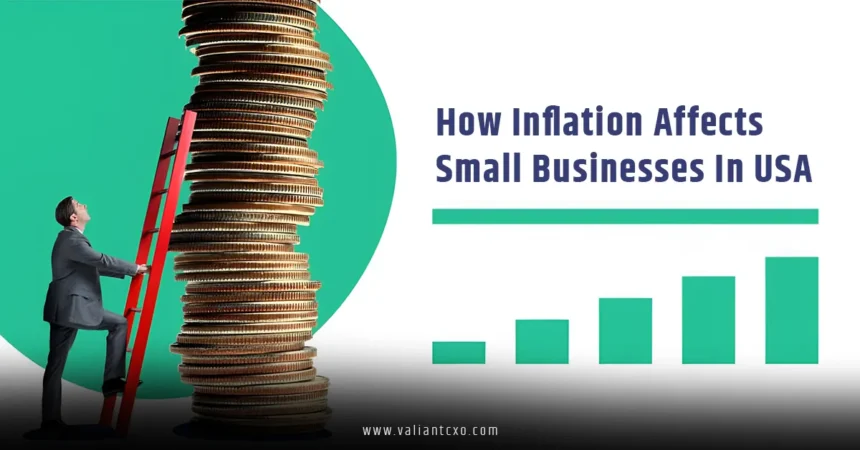How inflation affects small businesses in USA is a question that’s keeping many entrepreneurs up at night, especially as we navigate the economic twists and turns of 2025. Imagine your business as a small boat on a choppy sea—when inflation waves crash in, they can rock you hard, raising costs and shifting customer habits in ways that demand quick steering. But don’t worry; we’re diving deep into this topic to help you chart a steady course.
Inflation, at its core, is like that sneaky thief that slowly erodes the value of your dollar. It’s the general rise in prices over time, measured by things like the Consumer Price Index (CPI), and right now in the USA, it’s hovering around levels that make small business owners sweat. According to recent data, even as inflation has cooled from its 2022 peaks of over 9%, it’s still impacting operations with lingering effects on supply chains and consumer spending. Why does this matter so much for small businesses? Unlike big corporations with deep pockets and global reach, you’re often operating on razor-thin margins, making every price hike feel like a punch to the gut.
Let’s break it down: how inflation affects small businesses in USA isn’t just about higher bills—it’s a ripple effect touching everything from your daily operations to long-term growth plans. Think of it as a domino chain; one increase in raw material costs topples into higher wages, then into customer pushback, and before you know it, your profits are tumbling. But here’s the good news: with smart strategies, you can turn these challenges into opportunities to build a more resilient operation.
What Is Inflation and Why Should You Care?
Before we get into the nitty-gritty of how inflation affects small businesses in USA, let’s make sure we’re on the same page about what inflation really means. Picture this: a dollar bill that’s like a balloon slowly deflating over time. Inflation is that process where the purchasing power of your money shrinks because prices for goods and services are climbing. In the USA, the Federal Reserve aims for a steady 2% annual rate to keep the economy humming, but when it spikes—like it did post-pandemic—things get tricky.
Causes? It’s often a mix of demand-pull (too much money chasing too few goods), cost-push (rising production costs like fuel or wages), and built-in expectations where everyone assumes prices will keep going up. For small businesses, this isn’t abstract economics; it’s real life. Recent Census Bureau surveys show that bi-weekly business trends highlight how inflation has led to higher prices for goods and services, with small businesses reporting significant increases in what they pay suppliers. Have you noticed your utility bills creeping up or suppliers tacking on extra fees? That’s inflation at work, and it’s hitting small operations harder because you can’t always pass those costs on without scaring off customers.
Rhetorically speaking, why does how inflation affects small businesses in USA hit closer to home than for giants like Amazon? Simple: scale. Big firms can negotiate bulk deals or shift production overseas, but you’re likely sourcing locally and dealing with fixed contracts that don’t flex easily. This vulnerability means you need to stay vigilant—tracking CPI reports and economic forecasts isn’t just for Wall Street; it’s your survival toolkit.
The Direct Impacts: Rising Costs That Squeeze Your Bottom Line
Now, let’s talk about the frontline battles in how inflation affects small businesses in USA: those skyrocketing operational costs. It’s like trying to fill a leaky bucket—money keeps pouring out faster than you can pour it in. From raw materials to rent, inflation turns up the heat on your expenses, forcing tough choices.
Surging Supply and Material Costs
One of the biggest ways how inflation affects small businesses in USA is through the cost of goods sold (COGS). Suppliers pass on their higher expenses to you, whether it’s lumber for a construction firm or ingredients for a bakery. A Forbes report notes that since the pandemic, 92% of small business owners have seen at least a 20% jump in supply costs, leading to tighter cash flows. Imagine you’re running a coffee shop; coffee beans prices spike due to global supply issues, and suddenly your profit per cup shrinks. It’s not just annoying—it’s existential if you can’t adapt.
Supply chain disruptions amplify this. Remember the bottlenecks from 2021-2023? Even in 2025, echoes remain, with Census data showing domestic supplier delays dropping but still affecting 14.5% of small businesses. For you, this means stocking up might tie up capital, or shortages could halt production. Analogous to a chef without ingredients, you’re left scrambling.
Escalating Labor Expenses and Talent Retention
Labor is another hotspot in how inflation affects small businesses in USA. As living costs rise, employees demand higher wages to keep up—think of it as a wage-price spiral where everyone chases their tail. The US Chamber of Commerce reports that half of small businesses cite inflation as their top challenge, with many forced to hike pay amid a tight job market. If you’re a boutique retailer, paying more to keep staff means less for marketing or inventory.
But it’s not just wages; benefits like health insurance inflate too. In a low-unemployment era, retaining talent becomes pricier, and turnover costs add insult to injury. Have you felt the pinch when a key employee jumps ship for a better offer? That’s inflation fueling the fire.
Overhead Burdens: Rent, Utilities, and More
Don’t forget overheads in how inflation affects small businesses in USA. Rent hikes tied to CPI, utility bills soaring with energy prices—these are silent killers. Nationwide points out that inflation drives up everything from transportation to insurance, making cuts elsewhere inevitable. For a home-based service business, even fuel for deliveries bites harder.
It’s like juggling flaming torches; drop one, and the whole act falls apart. Small businesses often reduce inventory or marketing to cope, but that risks stunting growth.
Pricing Dilemmas and Shrinking Profit Margins
Ah, the pricing conundrum—central to how inflation affects small businesses in USA. Raise prices to cover costs? Risk losing customers. Keep them steady? Watch margins evaporate. Surveys show 89% of owners have hiked prices since 2020, but 37% worry it’ll deter buyers.
Profit margins compress like a squeezed sponge. Rising inputs outpace revenue if you can’t adjust fast enough. Forbes warns of tighter margins making profitability elusive. Rhetorically, how do you price a handmade craft when materials double? It’s a tightrope walk between survival and customer loyalty.
Interest rates compound this. Fed hikes to combat inflation make loans costlier, hitting expansion plans. If you’re borrowing for growth, higher rates mean less bang for your buck.
Shifts in Consumer Behavior and Demand
Consumers aren’t immune, so how inflation affects small businesses in USA includes changing buying habits. People cut back on non-essentials, seeking deals or switching to cheaper alternatives. The Hartford notes reduced demand as families tighten belts.
It’s like your customers suddenly going on a diet—your sales slim down too. Discretionary spending drops; a gift shop might see fewer impulse buys. But necessities like food or services can hold steady, though with price sensitivity.
Loyalty programs or value adds help, but inflation breeds caution. Small Biz Trends highlights decreased spending leading to revenue dips.
Long-Term Challenges: Growth and Investment Hurdles
Looking ahead, how inflation affects small businesses in USA extends to growth. High costs delay investments in tech or expansion. BULB app notes limited access to credit as rates rise, stalling plans.
Inventory management gets tricky—stock up and tie cash, or risk shortages. Profitability dips limit reinvestment, creating a stagnation cycle.
Yet, silver linings: inflation encourages efficiency. Small Biz Trends says it spurs innovation and job creation in some cases. Old debt cheapens too, easing repayments.
Strategies to Combat Inflation’s Grip
Enough doom—let’s talk solutions for how inflation affects small businesses in USA. You’re not powerless; proactive steps can shield you.
Smart Pricing Adjustments
Gradual increases beat shocks. Communicate transparently: “Due to rising costs, we’re adjusting slightly to maintain quality.” Nationwide advises this to retain customers.
Bundle products or add value—think free shipping to soften hikes.
Cost-Cutting Without Cutting Corners
Audit expenses: switch suppliers, go energy-efficient. Simmons Capital suggests negotiating bulk deals. Automate where possible—software for tracking saves time and money.
Reduce inventory smartly; just-in-time models minimize holding costs.
Diversifying Revenue and Building Resilience
Expand streams: online sales if brick-and-mortar. Entrepreneurs.ng recommends this for buffering. Tech investments boost efficiency, per The Hartford.
Build emergency funds; monitor trends via SBA resources.
Leveraging Government Support
USA policies like the Inflation Reduction Act offer tax credits. Check SBA loans or grants for relief.
Real-World Examples: Small Businesses Battling Inflation
Take a Montana firm hit by payroll and freight hikes—they raised prices and focused locally. Or Utah cleaners increasing wages but passing costs on. These stories show adaptation works.
In 2025, with inflation easing but persistent, agility is key.
Conclusion
In wrapping up how inflation affects small businesses in USA, remember: it’s a challenge, but one you can meet head-on. From rising costs squeezing margins to consumer shifts demanding flexibility, the impacts are real—but so are the strategies like smart pricing, cost cuts, and diversification. Stay informed, adapt quickly, and you’ll not only survive but thrive. You’ve got this—turn inflation’s pressure into your business’s diamond. Motivate yourself: every hurdle overcome builds a stronger foundation.
FAQs
How does inflation affect small businesses in USA compared to large corporations?
How inflation affects small businesses in USA often hits harder due to limited resources and pricing power, while big firms negotiate better deals and absorb costs easier.
What are the main ways how inflation affects small businesses in USA on daily operations?
Primarily through higher supply costs, wages, and overheads, forcing price hikes or cuts that impact profits.
Can how inflation affects small businesses in USA have any positive sides?
Yes, it can make old debt cheaper and push efficiency innovations.
How can I mitigate how inflation affects small businesses in USA in my pricing?
Adjust gradually, communicate changes, and add value to maintain customer loyalty.
Where can I find resources on how inflation affects small businesses in USA?
Check government sites like the SBA for guides and support programs.
For More Updates !! : valiantcxo.com


